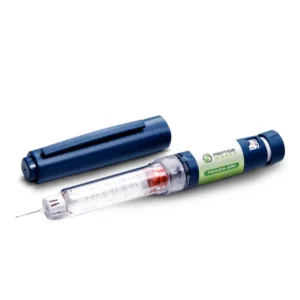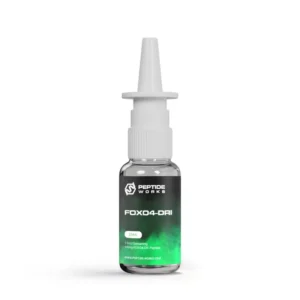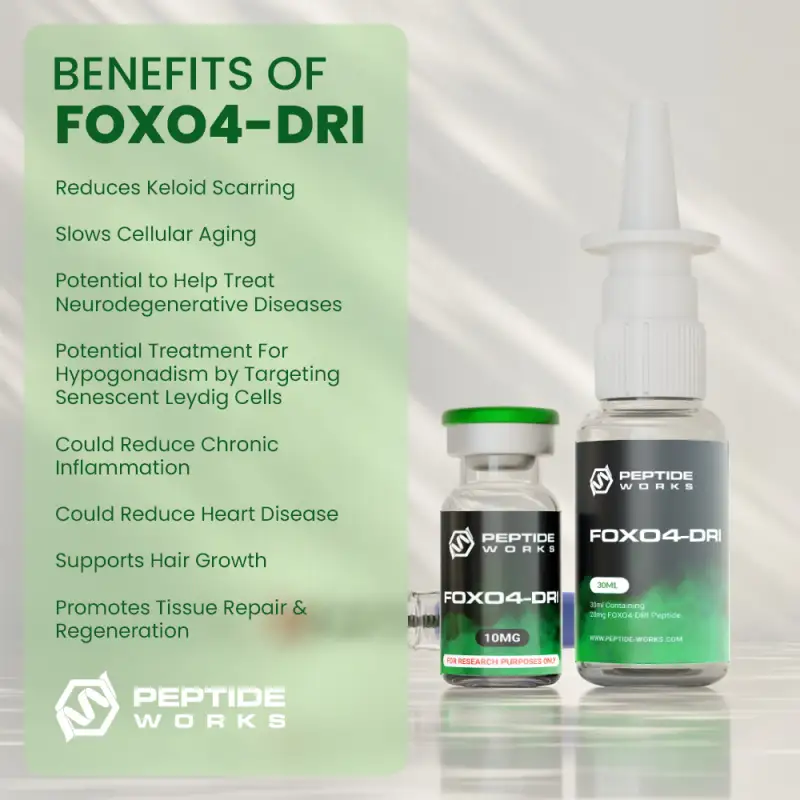PROMO!
First order? Get 10% OFF with this code: 1storder
Our Product Categories



The FOXO4-DRI peptide is a specially designed synthetic molecule that targets the FOXO4 protein, a member of the FOXO family of transcription factors. Its main goal is to influence important cellular processes related to aging, cellular senescence, and programmed cell death, also known as apoptosis.
Cellular senescence is the stage at which cells stop dividing and start to gather in our tissues, which can lead to inflammation and other issues associated with aging. By focusing on these processes, FOXO4-DRI is intended to help remove these damaged or dysfunctional cells from the body, which can otherwise disrupt normal tissue function and contribute to age-related problems.
The peptide is now being studied for its ability to address age-related diseases, promote tissue health and stimulate cellular rejuvenation. Its potential influence on these crucial processes renders it a potentially powerful tool in better understanding cellular aging and in developing novel treatments in regenerative medicine and age-related health problems.
Peptide Sequence (IUPAC Condensed): H-D-Leu-D-Thr-D-Leu-D-Arg-D-Lys-D-Glu-D-Pro-D-Ala-D-Ser-D-Glu-D-Ile-D-Ala-D-Gln-D-Ser-D-Ile-D-Leu-D-Glu-D-Ala-D-Tyr-D-Ser-D-Gln-D-Asn-Gly-D-Trp-D-Ala-D-Asn-D-Arg-D-Arg-D-Ser-Gly-Gly-Lys-Arg-Pro-DL-Pro-DL-Pro-Arg-Arg-Arg-Gln-Arg-Arg-Lys-Lys-Arg-Gly-OH
Molecular Formula:
C228H388N86O64
Molecular Weight:
5358 g/mol
Synonyms: FOXO4 D-Retro-Inverso peptide
View the FOXO4-DRI COA
View the FOXO4-DRI HPLC

FOXO4-DRI works by breaking the connection between the FOXO4 protein and p53, a protein that controls cell survival and death. Normally, FOXO4 binds to p53 in senescent cells (cells that no longer divide but are still active), stopping p53 from triggering apoptosis, or programmed cell death. This allows these damaged or dysfunctional cells to persist, which can contribute to tissue dysfunction, inflammation, and aging-related diseases.
The FOXO4-DRI peptide is designed to mimic a portion of the FOXO4 protein, but with a key difference: it competes with the natural FOXO4 protein for binding to the p53 protein. FOXO4-DRI binds to p53 and breaks the protective link between them. This allows p53 to trigger the apoptotic pathway, removing senescent cells while leaving healthy, functional cells unharmed.
By clearing out these “zombie” cells, FOXO4-DRI helps reduce the negative effects of cellular aging, like chronic inflammation and tissue damage. This can improve tissue health and possibly slow down aging. As a result, FOXO4-DRI has become a key area of research in aging, regenerative medicine, and treatments for age-related diseases.
Selective Senescent Cell Clearance: FOXO4-DRI exhibits potent senolytic action by selectively targeting the FOXO4-p53 axis, a key regulator of cellular senescence. By disrupting the FOXO4-p53 interaction, FOXO4-DRI induces p53 nuclear exclusion, leading to apoptosis in senescent cells while sparing healthy ones. This targeted clearance of senescent cells restores tissue homeostasis and mitigates aging-related diseases. Its ability to modulate cellular senescence highlights FOXO4-DRI as a promising therapeutic strategy for combating age-related morbidity and dysfunction [1].
Cancer Research: FOXO4-DRI demonstrates significant potential in cancer therapy by targeting and eliminating senescent cancer cells. Disrupting the FOXO4-p53 interaction induces p53-mediated apoptosis, effectively clearing senescent cells that contribute to cancer progression and recurrence.
Studies show FOXO4-DRI enhances cell death in senescent cancer cells and improves survival in mouse melanoma models when combined with a BRAF inhibitor [2]. This senolytic approach offers a promising strategy for eradicating residual disease and improving cancer treatment outcomes.
Neurodegeneration and Cognitive Function Research:Research shows FOXO4-dri has potential in combating neurodegeneration and cognitive decline by targeting senescent cells, a key driver of age-related diseases like Alzheimer’s. By disrupting FOXO4-p53 interactions, it promotes apoptosis in senescent cells, reducing inflammation and improving cellular health [3].
Studies have demonstrated that FOXO proteins, including FOXO4, regulate oxidative stress responses and mitochondrial function, which are critical in neurological disorders. Senolytic therapies like FOXO4-DRI may offer a promising approach to modulate aging and halt neurodegenerative disease progression [4]. Further research is needed to assess safety, dosage, and potential side effects.
Wound Healing and Regeneration: FOXO4-DRI’s senolytic action reduces senescent cell burden in chronic wounds, improving healing outcomes and preventing excessive fibrosis. In keloids, it disrupts the FOXO4-p53 interaction, inducing apoptosis in senescent fibroblasts and reducing pro-inflammatory and mesenchymal fibroblast subpopulations. This alleviates the persistent senescent microenvironment that drives keloid aggressiveness and recurrence [5]. These findings highlight its potential in regenerative medicine and scar management.
Reproductive Health: FOXO4-DRI shows promise in improving reproductive health by targeting senescent Leydig cells, which contribute to age-related hypogonadism and reduced fertility. Studies reveal that the peptide disrupts the FOXO4-p53 interaction, inducing apoptosis in senescent Leydig cells and restoring testicular homeostasis [6].
In aged mice, it improved testosterone levels, sperm quality, and spermatogenesis by enhancing the testicular microenvironment [7]. These findings highlight FOXO4-DRI’s therapeutic potential for addressing male late-onset hypogonadism and age-related fertility decline.
New Hair Growth: Research indicates FOXO4-DRI promotes hair growth by targeting senescent cells that impair tissue function and follicular health. By disrupting the FOXO4-p53 interaction, it induces apoptosis in senescent cells, restoring tissue homeostasis.
Studies show FOXO4-DRI improved fur density in aged mice, highlighting its potential to rejuvenate hair follicles and combat age-related hair loss. This senolytic approach offers a promising therapeutic strategy for restoring hair growth and overall scalp health in aging individuals [8].
[1] Benjamin Bourgeois and Tobias Madl (2018) Regulation of cellular senescence via the FOXO4‐p53 axis – FEBS Letters, 2018 May 13, Volume 592 (Issue 12), Pages 2083–2097.
[2] Hillary H Le, Suleyman S Cinaroglu, Elise C Manalo, Aysegul Ors, et al (2021) Molecular modelling of the FOXO4-TP53 interaction to design senolytic peptides for the elimination of senescent cancer cells – eBioMedicine, 2021 Oct 21, Volume 73, Page 103646.
[3] Y Asadi, R K Moundounga, A Chakroborty, A Pokokiri, and H Wang (2025) FOXOs and their roles in acute and chronic neurological disorders – Frontiers in Molecular Bioscience. 2025 Apr 7, Volume 12, Page 1538472
[4] M Riessland and ME Orr (2023) Translating the Biology of Aging into New Therapeutics for Alzheimer’s Disease: Senolytics – The Journal of Prevention of Alzheimer’s Disease, Volume 10, Issue 4, November 2023, Pages 633-646.
[5] Yu-Xiang Kong, Zhi-Shuai Li, Yuan-Bo Liu, Bo Pan, et al (2025) FOXO4-DRI induces keloid senescent fibroblast apoptosis by promoting nuclear exclusion of upregulated p53-serine 15 phosphorylation – Communications Biology, volume 8, Article number: 299 (2025).
[6] Chi Zhang, Yun Xie, Haicheng Chen, Linyan Lv, et al (2020) FOXO4-DRI alleviates age-related testosterone secretion insufficiency by targeting senescent Leydig cells in aged mice – Aging (Albany NY). 2020 Jan 20, Volume 12 (Issue 2), Pages 1272–1284.
[7] Yanqing Li, Chi Zhang, Haicheng Cheng, LinYan Lv, et al (2024) FOXO4-DRI improves spermatogenesis in aged mice through reducing senescence-associated secretory phenotype secretion from Leydig cells – Experimental Gerontology. 2024 Oct 1, Volume 195, Page 112522.
The answers to the most frequently asked questions about FOXO4-DRI.

Buy FOXO4-DRI Peptide Nasal Spray from Peptide Works. Available in 15ml and 30ml glass spray bottles, this non-invasive option provides a simple and effective method for controlled research applications.
FOXO4-DRI is not approved by the U.S. Food and Drug Administration (FDA) for human or veterinary use. It is sold for research purposes only. The FDA prohibits its sale or use as a drug, supplement, or treatment in humans.
There is no clinical data on the side effects of FOXO4-DRI. Preclinical studies show minimal toxicity in research models, though some reports note temporary fatigue, nausea, or mild injection-site irritation. Its long-term safety and potential risks remain unknown, requiring further scientific investigation to determine a complete safety profile.
Studies in aged mice show FOXO4-DRI may support testosterone production by clearing senescent Leydig cells and improving testicular function. These findings suggest potential hormonal benefits in research, making FOXO4-DRI an interesting peptide for scientists exploring cellular aging and endocrine health mechanisms.
Research suggests FOXO4-DRI targets senescent cells by disrupting the FOXO4–p53 interaction, allowing damaged cells to undergo apoptosis. This process may support studies on aging and cellular renewal. These findings are based on laboratory research, making FOXO4-DRI valuable for scientists exploring senolytic mechanisms.

This blog explores the potential of FOXO4-DRI and other peptides like GHK-Cu and BPC-157 in keloid treatment therapy. It highlights their roles in reducing senescent cells, managing inflammation, and balancing collagen production to improve scar healing. These peptides offer promising insights for future keloid and scar management research.

This blog explores the potential of FOXO peptides in anti-aging research, focusing on their ability to regulate genes, promote autophagy, and combat oxidative stress. It highlights FOXO4-DRI’s role in removing senescent cells and supporting tissue regeneration. These peptides offer promising insights into cellular health and longevity, advancing anti-aging science.

This blog takes a deep look at the potential of peptides such as B7-33 and FOXO4-DRI in reducing fibrosis and aiding tissue repair. These compounds work by blocking damaging pathways, clearing senescent cells, and activating RXFP1 receptors to limit scarring. It also explores how stem cells and new research address chronic inflammation and fibrosis.
ALL CONTENT AND PRODUCT INFORMATION AVAILABLE ON THIS WEBSITE IS FOR EDUCATIONAL PURPOSES ONLY.
DISCLAIMER: These products are intended solely as a research chemical only. This classification allows for their use only for research development and laboratory studies. The information available on our Peptide Works website: https://peptide-works.com/ is provided for educational purposes only. These products are not for human or animal use or consumption in any manner. Handling of these products should be limited to suitably qualified professionals. They are not to be classified as a drug, food, cosmetic, or medicinal product and must not be mislabelled or used as such.